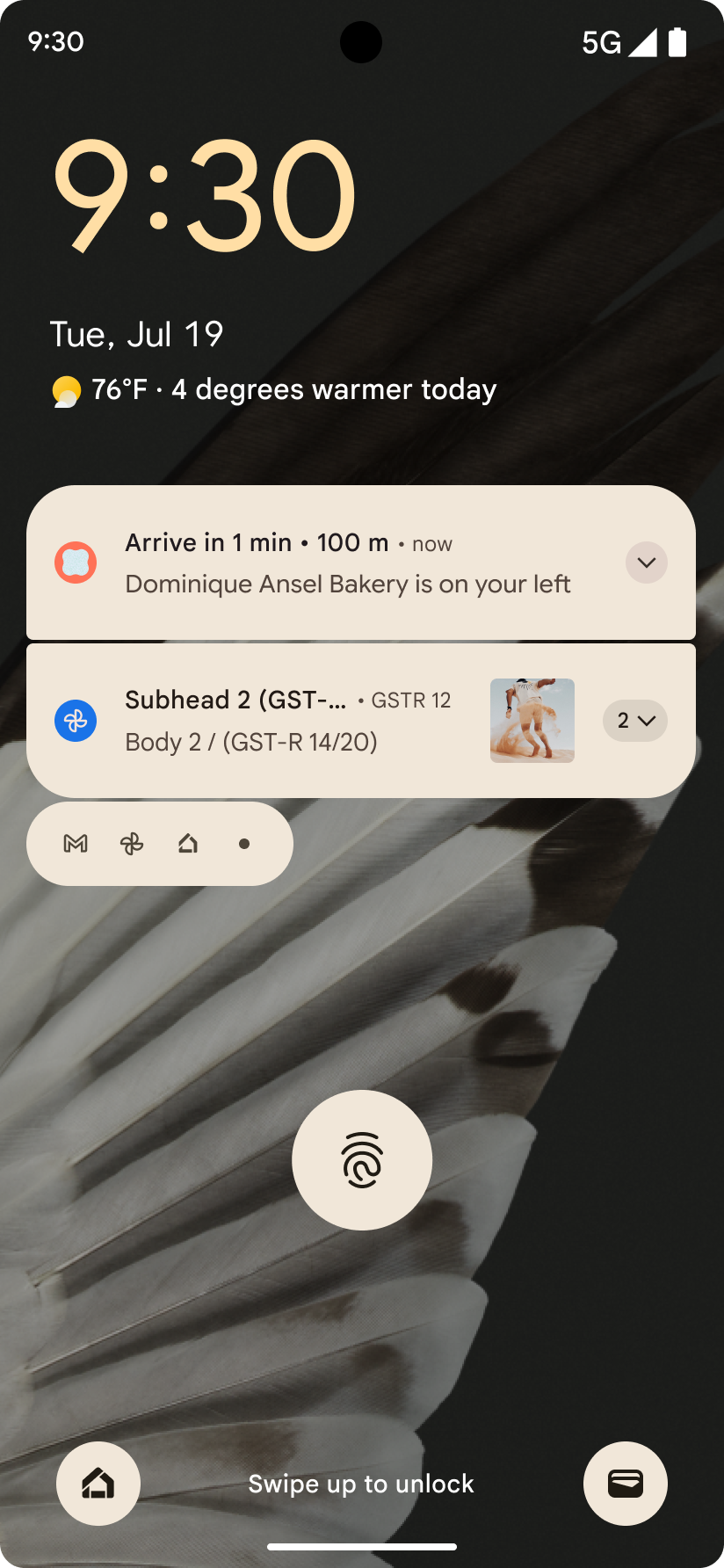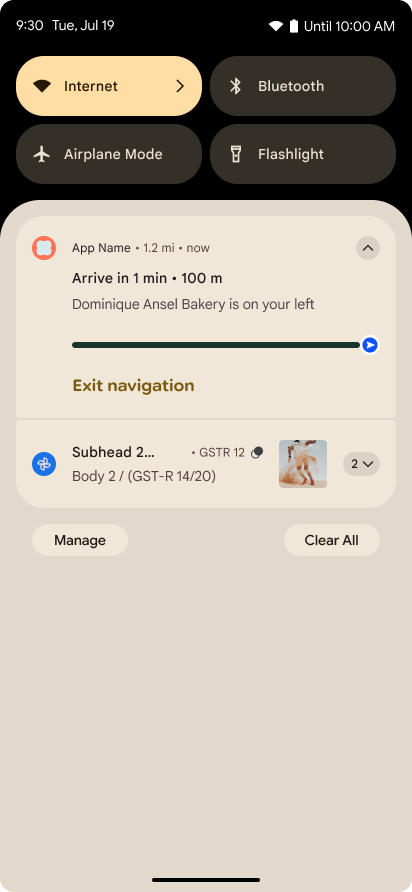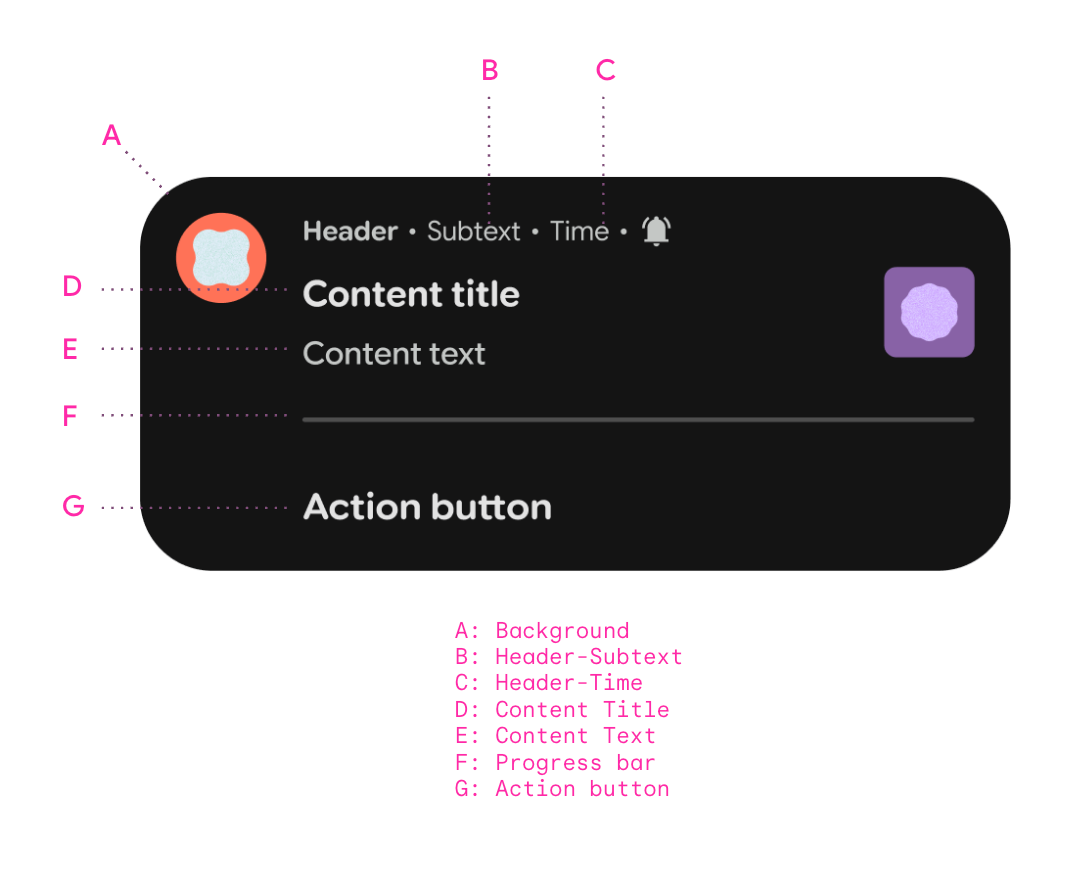In Android 16 werden nutzungsorientierte Benachrichtigungen eingeführt, mit denen Nutzer den Fortschritt von von ihnen initiierten Abläufen von Anfang bis Ende verfolgen können.
Notification.ProgressStyle ist ein neuer Benachrichtigungsstil, mit dem Sie fortschrittsorientierte Benachrichtigungen erstellen können. Zu den wichtigsten Anwendungsfällen gehören Ridesharing, Lieferservice und Navigation. Innerhalb der Klasse Notification.ProgressStyle können Sie Zustände und Meilensteine in einer User Journey mithilfe von Punkten und Segmenten angeben.


Relevante Klassen und Methoden
Die folgenden Klassen enthalten die verschiedenen APIs, mit denen du eine ProgressStyle-Benachrichtigung erstellst:
Anatomie und Anpassung
Die folgenden Bilder zeigen die verschiedenen Teile von ProgressStyle-Benachrichtigungen:
Die folgenden Bilder zeigen die verschiedenen Teile von ProgressStyle-Benachrichtigungen:

A. Überschrift – Untertitel |
|
B. Kopfzeile – Zeit |
|
C. Titel des Inhalts |
|
D. Inhaltstext |
|
E. Fortschrittsanzeige |
|
F. Aktionsschaltfläche |

Best Practices
Beachten Sie die folgenden Best Practices, um Nutzern mit nutzungsorientierten Benachrichtigungen die bestmögliche Nutzererfahrung zu bieten:
- Achten Sie darauf, dass die richtigen Felder für die Sichtbarkeit von Anzeigen festgelegt sind.
- Verwenden Sie die richtigen visuellen Elemente, um die Nutzer durch den Kaufprozess zu leiten. So sollten beispielsweise Rideshare-Apps ein Fahrzeugbild und die möglichst genaue Farbe des Fahrzeugs festlegen, das für die Fahrt verwendet wird. Verwenden Sie dazu
Notification.setLargeIcon(). - Beschreiben Sie den Fortschritt dieses Kaufprozesses in einer prägnanten und klaren Sprache. Ankunftszeit, Name des Fahrers und Fahrtstatus sind wichtige Informationen, die in der Benachrichtigung enthalten sein sollten.
- Bieten Sie in der Benachrichtigung nützliche und relevante Aktionen an, die die User Journey optimieren. Beispiele für Aktionen vor der Lieferung sind das Geben eines Trinkgelds oder das Hinzufügen eines zusätzlichen Gerichts zu einer neu aufgegebenen Bestellung für die Lieferung von Lebensmitteln.
- Verwenden Sie Segmente und Punkte, um Zustände anzugeben. Sie können beispielsweise Segmente verwenden, um den Status und die Dauer von Staus bei einer Fahrt mit einem Mitfahrdienst zu färben, und Punkte für Status für Meilensteine, die Zubereitung von Speisen, die Lieferung und die Abholung von Fahrgästen.
- Aktualisieren Sie den Fortschritt häufig und genau, damit er dem tatsächlichen Fortschritt der Fahrt entspricht. So können sich beispielsweise sich ändernde Verkehrsbedingungen in Änderungen der Segmentfarben und Aktualisierungen im Text widerspiegeln.
Das folgende Code-Snippet zeigt, wie eine ProgressStyle-Benachrichtigung für einen Kontext für Fahrgemeinschaften verwendet werden könnte:
var ps =
Notification.ProgressStyle()
.setStyledByProgress(false)
.setProgress(456)
.setProgressTrackerIcon(Icon.createWithResource(appContext, R.drawable.ic_car_red))
.setProgressSegments(
listOf(
Notification.ProgressStyle.Segment(41).setColor(Color.BLACK),
Notification.ProgressStyle.Segment(552).setColor(Color.YELLOW),
Notification.ProgressStyle.Segment(253).setColor(Color.WHITE),
Notification.ProgressStyle.Segment(94).setColor(Color.BLUE)
)
)
.setProgressPoints(
listOf(
Notification.ProgressStyle.Point(60).setColor(Color.RED),
Notification.ProgressStyle.Point(560).setColor(Color.GREEN)
)
)
Beachten Sie, dass in diesem Beispiel ein Fahrzeugbild für das Trackersymbol festgelegt ist und Segmente und Punkte verwendet werden, um die Fahrtenoption und Meilensteine zu kennzeichnen, um eine umfassendere Nutzererfahrung zu bieten.
Weitere Informationen finden Sie in der Beispiel-App.

